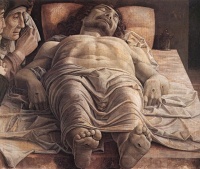Animal decomposition
From The Art and Popular Culture Encyclopedia
|
Related e |
|
Featured: |
Decomposition begins at the moment of death, caused by two factors: autolysis, the breaking down of tissues by the body's own internal chemicals and enzymes, and putrefaction, the breakdown of tissues by bacteria. These processes release compounds such as cadaverine and putrescine, that are the chief source of the unmistakably putrid odor of decaying animal tissue.
Prime decomposers are bacteria or fungi, though larger scavengers also play an important role in decomposition if the body is accessible to insects, mites and other animals. The most important arthropods that are involved in the process include carrion beetles, mites, the flesh-flies (Sarcophagidae) and blow-flies (Calliphoridae), such as the green-bottle fly seen in the summer. The most important non-insect animals that are typically involved in the process include mammal and bird scavengers, such as coyotes, dogs, wolves, foxes, rats, crows and vultures. Some of these scavengers also remove and scatter bones, which they ingest at a later time. Aquatic and marine environments have break-down agents that include bacteria, fish, crustaceans, Diptera larvae and other carrion scavengers.



